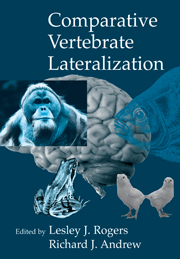Book contents
- Frontmatter
- Contents
- List of Contributors
- Preface
- Introduction
- Part one Evolution of lateralization
- 1 How ancient is brain lateralization?
- 2 The earliest origins and subsequent evolution of lateralization
- 3 The nature of lateralization in tetrapods
- 4 Advantages and disadvantages of lateralization
- Part two Development of lateralization
- Part three Cognition and lateralization
- Part four Lateralization and memory
- Epilogue
- Author Index
- Subject Index
- Richard Andrew
3 - The nature of lateralization in tetrapods
Published online by Cambridge University Press: 10 December 2009
- Frontmatter
- Contents
- List of Contributors
- Preface
- Introduction
- Part one Evolution of lateralization
- 1 How ancient is brain lateralization?
- 2 The earliest origins and subsequent evolution of lateralization
- 3 The nature of lateralization in tetrapods
- 4 Advantages and disadvantages of lateralization
- Part two Development of lateralization
- Part three Cognition and lateralization
- Part four Lateralization and memory
- Epilogue
- Author Index
- Subject Index
- Richard Andrew
Summary
Introduction
The hypothesis that all vertebrate groups inherit a common basic pattern of lateralization from a common chordate ancestor was advanced in Chapter 2. Here we examine the evidence available from tetrapods to see how far this hypothesis can be sustained. We consider mainly tetrapods other than primates, as primates are examined in other chapters. Nevertheless, since so much more is known of human lateralization than that of any other vertebrate, a final test of each aspect of the hypothesis is how far it is consistent with evidence of lateralization in humans.
The evidence available so far supports our view that there is a common basic pattern of lateralization in all vertebrates. It is, of course, possible that there has been loss or reorganization of the basic pattern of lateralization in some species, but there is no certain example of this as yet. The absence of asymmetry in one or a few tests on a particular species is not strong evidence of its absence, as is clearly exemplified by the work of Hamilton and Vermeire (1983, 1988), who, after providing a large body of negative findings for the rhesus monkey, went on to produce an impressive body of evidence for brain lateralization in that species. Their findings are now corroborated by other studies (see Chapter 12 by Hopkins and Carriba).
In this context, and before beginning a comparative review of evidence for lateralization in tetrapods, some comment is needed on lateralization in rats and mice.
- Type
- Chapter
- Information
- Comparative Vertebrate Lateralization , pp. 94 - 125Publisher: Cambridge University PressPrint publication year: 2002
- 49
- Cited by

